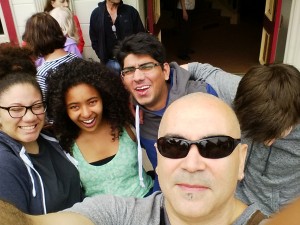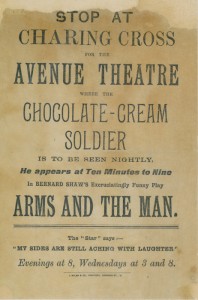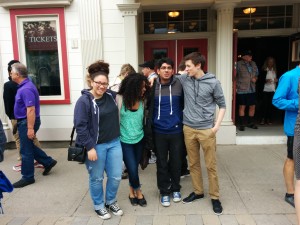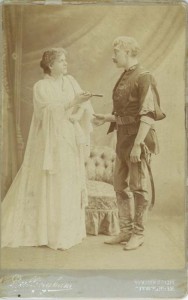Prepared by Dr. Liam Rodrigues
Research assistant: Alicia Alexander
Context: Re-contextualising Shaw, the Age and his Sources
Dismantling the Codes: Looking at Anti-Romanticism, War & Oppression in Shaw
Gender, Class, Freedom and Identity: the Master/Slave Dynamic
Modalities of Power and the Formation of Knowledge
The “Other” Europe: Balkanism and Postcolonialism
Appendices
****************************************************************************************
Dr. Liam Rodrigues and his students attending the Arms and the Man Performance at the Shaw Festival, June, 2014. (Photos supplied by Dr. Liam Rodrigues)

George Bernard Shaw’s Arms and the Man: Inclusive Online Curricular Materials
By Dr. Liam Rodrigues
G. B. Shaw is a playwright and co-founder of the London School of Economics. As something of a rare figure, whose fame had a solid foothold in both the Nineteenth and Twentieth Centuries, he is an icon too often visited through a fixed lens. Revisiting what we think we know about Shaw, the issues and conflicting ideologies of the age renew how we can envision his contribution to the global contemporary culture.

Copyright 1998-2008, Global Performing Arts Consortium. All Rights Reserved.
Welcome to the Arms and the Man: Inclusive Online Curricular Materials. Focused on rethinking approaches to critical engagement, this page is designed to produce both an expansive and inclusive engagement with George Bernhard Shaw’s classic. Amongst his earliest commercial successes, Arms and the Man was first staged on April 21, 1894, and later published in Plays Pleasant (1898), together with Candida, You Never Can Tell and The Man of Destiny. Traditionally, it has been received as an antiromantic comedy that highlights the pointlessness of war while troubling questions of class, gender and human hypocrisy.
Over the intervening 120 years, Arms and the Man has been revived countless times around the globe; has been adapted to operetta, film, radio and musical theatre, and continues to be numbered amongst Shaw’s masterworks. Where others of his plays—executed with no less skill and artistry—have become less relevant in the wake of progressive, social change, Arms and the Man continues to question and provoke the human project.
Associated pages explore a range of post-structural themes and approaches.
Below are relevant preparatory links (hosted on youtube) to a Center Rep production, a filmed London stage production and a public-domain audiobook, respectively:
… an inside look at how Center REP brings the wit and the romantic comedy of George Bernard Shaw’s classic Arms and the Man to the stage.
https://www.youtube.com/watch?v=n7ETZFsiWWw
A London stage production of George Bernard Shaw’s play “Arms and the Man, directed by Philip Casson; with Richard Briers, Alice Krige, Peter Egan, Richard Pearson.
http://www.youtube.com/watch?v=_4FchU7tumI
http://www.youtube.com/watch?v=FHs1lTHlWww
******************************************************************
You may also wish to have a look at the videos of various theatre productions and behind-the-scene interviews.
Don’t forget to scroll down for the adaptation of Arms and The Man in the operetta The Chocolate Soldier!
Shaw’s inversion of conventional late Victorian romantic melodrama on love and war and class
Arms and the Man, written by George Bernard Shaw in 1898, was set in 1885 during the Serbo-Bulgarian war. A young Bulgarian woman named Raina was engaged to Sergius Saranoff, a war hero winning a cavalry charge and a man she adores. Her romantic illusions on war and love are soon shattered when Bluntschli, a Swiss who serves as a professional soldier fighting on the Serbian side, reveals the reality behind militarism: he carries chocolate creams instead of cartridges, and Sergius’s cavalry charge was successful only because the Serbian army had the wrong cartridges. There turns out to be no “higher love” either, when Raina finds that Sergius is really in love with her servant girl, Louka. Raina picks her “Chocolate Cream Soldier” Bluntschili, without knowing that he happens to be much richer than Sergius, inheriting his father’s chain of hotels.
What is important to note is how the Shavian heroines, Raina and Louka, control their destines and the men around them.
Please visit the Arms and the Man page for the various productions, audiobooks, and background of the play.
The Chocolate Soldier-Adaptation of Arms and the Man
The play was first adapted into an operetta by the name of The Chocolate Soldier in 1908. Shaw permitted the rights to the adaptions to Leopold Jacobson provided he’d follow Shaw’s three conditions: they would not use Shaw’s dialogue, nor any of Shaw’s character’s names; it must be advertised as a parody of his play; and that Shaw himself would not be compensated. Instead, the play could use the plot and its central message. Despite the fact that Shaw despised the outcome of the play it became an international success, and the playwright grew to regret his not being financially compensated.
Click here to watch the original theatrical trailer of the 1941 film adaption of The Chocolate Soldier.
Click here to listen to one of the waltzes orchestrated by Viennese composer Oscar Straus for the original production of The Chocolate Soldier.
Click here to listen to the full audiobook of the play.



